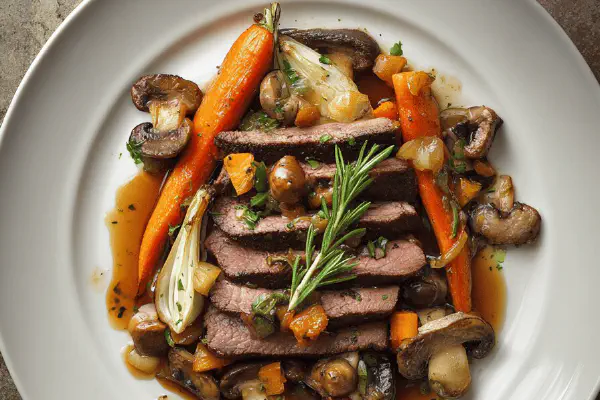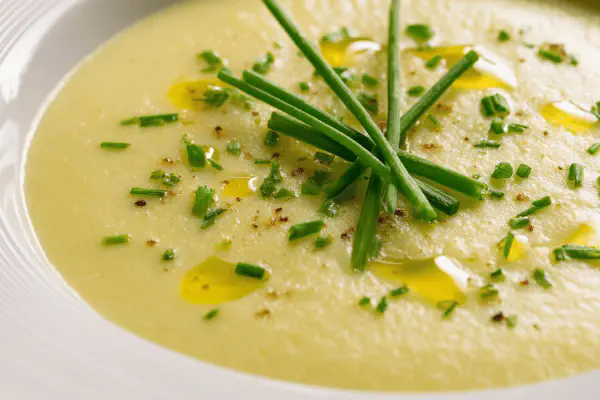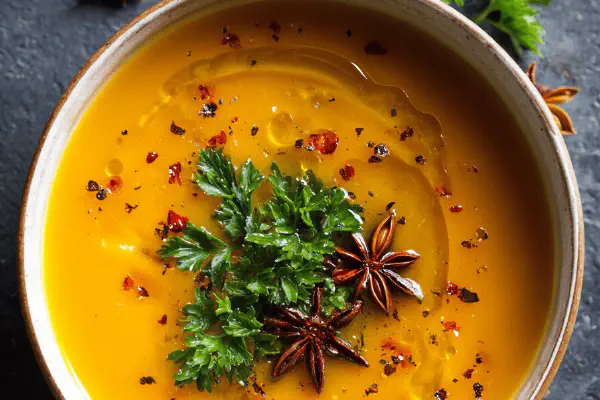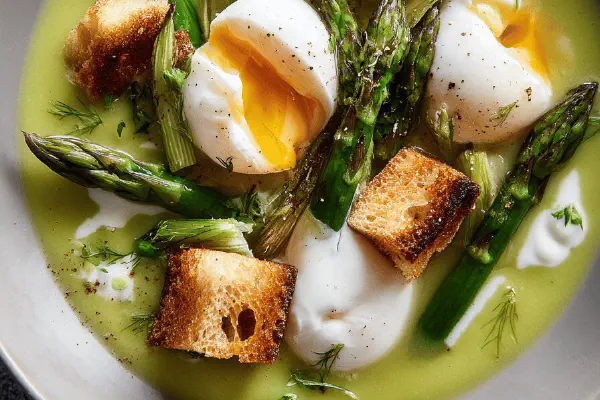Creamy Asparagus Mussel Soup
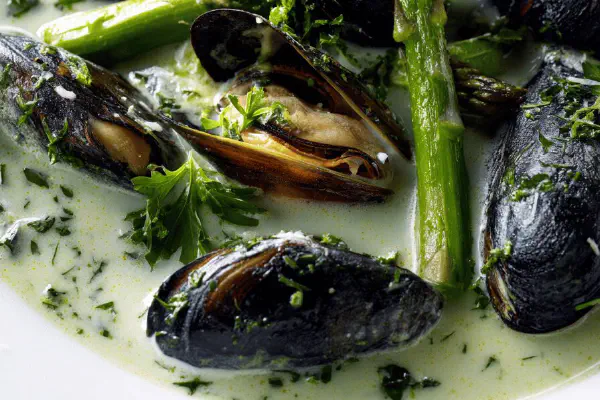
By Emma
Certified Culinary Professional
Ingredients
Garlic Croûtons
- 10 thin baguette slices
- 40 ml (3 tbsp) olive oil plus extra for finishing
- 1 clove garlic
Mussels in White Wine
- 1 shallot minced
- 1 clove garlic minced
- 15 ml (1 tbsp) olive oil
- 150 ml (2/3 cup) dry white wine
- 900 g (2 lb) mussels cleaned
Asparagus Velouté
- 1 leek white part, sliced thin
- 1 litre (4 cups) vegetable broth
- 1 medium yam, peeled diced
- 850 g (30 oz) green asparagus, trimmed, cut in pieces
- 15 ml (1 tbsp) chopped fresh parsley
- Zest of half a lemon
About the ingredients
Method
Garlic Croûtons
- Rack in center position. Heat oven to 230°C (445°F). Line tray with parchment or silicone mat.
- Brush baguette slices evenly with olive oil. Roast 7 minutes until just golden edges appear, not too dark. Can hear subtle crackle.
- Cool enough to handle. Rub garlic clove lightly on each slice—avoid overpowering raw sharpness; just hint.
- Break croûtons roughly for texture contrast during service.
Mussels in White Wine
- Warm olive oil in large deep pan over medium-high heat.
- Sweat shallot and garlic gently until transparent, not browned—about 3 minutes, smell releases sweet onion base.
- Add white wine; bring quickly to boil; sharp steam bursts aroma.
- Toss mussels in, cover, cook 5 minutes or until shells fling open like tiny fans, no less, no mussels left closed.
- Remove mussels with slotted spoon to tray; discard unopened shells.
- Shell all mussels while still warm but manageable, set aside.
- Strain cooking liquid through fine sieve into bowl; discard solids for clear broth.
Asparagus Velouté
- In same pan, add leek slices with 15 ml olive oil; cook medium heat, stirring till soft and sweet-smelling, about 7 minutes—patience here builds deeper flavor.
- Pour in reserved mussel broth and vegetable stock. Add diced yam. Bring to gentle boil; simmer 12 minutes until yam is tender to fork, stirring occasionally to prevent sticking or burning.
- Add asparagus pieces; cook 7 minutes until bright jade and tender but not mushy. You want a slight bite.
- Transfer soup in batches to blender, puree until luxuriously smooth; adjust seasoning with salt and cracked black pepper.
- Return to pot to warm through. Stir in fresh parsley and lemon zest—zest wakes up the palate, brightens dish.
- Check consistency; add bit of water or stock if too thick. Heat off once just hot before serving.
- Serve soup hot in bowls; scatter shelled mussels promptly atop.
- Sprinkle with garlic croûtons and fresh parsley.
- Drizzle good olive oil over all—a silky finish.
- Optional squeeze lemon wedges tableside for those who want sharper acidity.
- Eat immediately while textures stand out—smooth, briny, crisp toasted.
Cooking tips
Chef's notes
- 💡 Start croûtons first. High heat makes edges golden fast but watch closely. Sugar caramelizes quickly; burn risk real. Rub garlic lightly only when bread cools—raw garlic can sting. Break roughly to keep rustic crunch contrast later. Baguette slices or day-old bread soak oil better. Olive oil quality matters. Croûtons lose crisp if too early; serve fast or side plate.
- 💡 Sweat shallots and garlic gently. No browning or soup turns bitter. Soft translucence signals ready phase. Aromas shift subtle sweet onion base. White wine boil triggers sharp steam burst—watch for quick reduction. Mussel shells pop open like tiny fans; stop exactly then or rubbery soggy meat. Discard any closed mussels still; safer and texture better. Use slotted spoon to remove meat—keep cooked warmth for easy shelling.
- 💡 Leeks build soup base; stir constantly, medium heat. Patience here; soft smell is checkpoint. Yam swapped for potatoes doesn’t puree same. Yam adds silk and holds more body after blending. Pour broth carefully; avoid over-reducing mussel juice or soup turns salty. Add asparagus last to keep jade green brightness and slight bite. Avoid mushy; texture contrast a focus. Blend in small batches for uniform velvet. Season only post-blend.
- 💡 Croûtons, mussel broth, parsley, and lemon zest balance. Parsley freshens; optional tarragon or chives shift herb profile. Lemon zest late; preserves sharpness, wakes palate. Olive oil drizzle final step—fruity, peppery oil lifts mouthfeel; cheap oil dulls depth. Croûtons scattered just before eating to maintain crispness; standing croûtons soften fast. Keep soup hot but off heat before serving—overheat dulls aromas and thickens unexpectedly.
- 💡 Shell mussels warm but manageable; cold slows process, hot burns fingers. Strain broth fine; any grit ruins texture immediately. Using same pan cuts flavor loss but requires quick cleaning or gentle residue to avoid bitterness. Wine choice affects final tone; Sauvignon Blanc bright, Chardonnay fuller. Alternatives: clams/cockles—adjust cook time down for delicate shellfish. If yam unavailable, russet or waxy potatoes work with slight texture change.
Common questions
How to avoid burnt croûtons?
High oven temp cooks fast. Watch edges. Remove right when golden. Rub garlic only when bread cooled. Oil amount count. Stale bread soaks better. Too long burns sugar and oil together.
What to do if mussels don’t open?
Discard closed ones after cooking. They can be bad. Check cooking time; shells pop open in 5 minutes. Sometimes undercooked. Avoid eating those. Alternative shellfish like clams need less cook time.
Can I replace yam with potatoes?
Yes, but texture changes. Yam keeps puree smooth and holds better. Potatoes add starch; puree might be thicker or grainier. Use waxy or russet, adjust simmer times. More stirring stops sticking. Drain excess liquid if too thick.
How best to store leftover soup?
Cool quickly, fridge within two hours. Reheat gently; avoid boiling to keep flavors bright. Croûtons lose crisp fast; store separately in airtight. Soup thickens on standing, add water or stock when reheating but taste first. Can freeze, but texture shifts after thaw.
